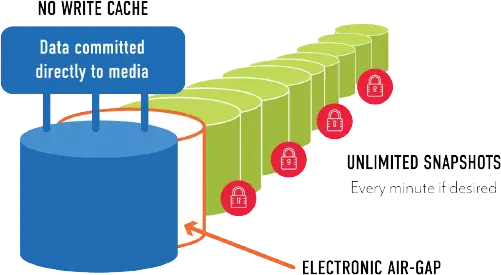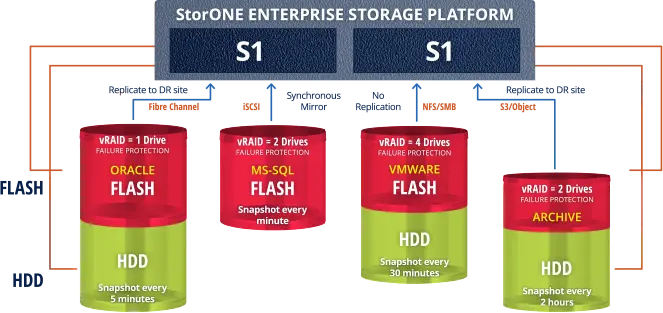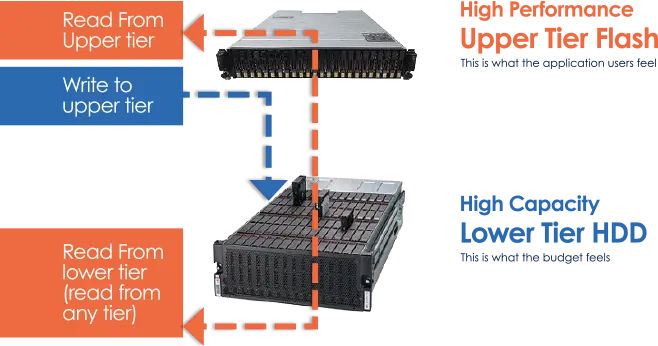Cost creep is always a factor with data storage. Data storage is the only technology that is not just used but also consumed. Data is always being created and needs to be stored. That consumes capacity. Unfortunately, there are several key aspects of data storage systems that needlessly increase cost.
ONGOING COST CREEP
PROBLEMS

Data storage software licensing, subscription, or as-a-service tied to capacity
Most data storage software cost is tied to installed system capacity, not consumed capacity. Even when that capacity is never used. When higher capacity drives are implemented, that cost goes up. The software is not working any harder, doing more, or requiring additional maintenance. And yet, the software costs automatically go up.
Multiple data storage systems for different protocols adds much greater cost than expected
Common sense says more data storage systems equals more cost. Except that additional cost is much more than linear.
More systems require more rack space (allocated data center fixed overhead), power, cooling, cables, transceivers, switch ports, switches, and all of which equals more cost. Each different protocol data storage system necessitates different training, skills, knowledge, and experience leading to more or more expensive data storage administrators. Keep in mind that the data storage software cost will be more as well since they are licensed, subscribed, or as-as-service per system in addition to being tied per terabyte.
Multiple data storage systems for performance adds much greater cost than expected
When the performance issue rears its ugly head, more data storage systems are implemented. This requires different application workloads to target different data storage systems. That’s not happening on its own or automatically.
That requires admin intervention and a lot of time. There are still the additional costs of multiple systems, geometrically increased management time, license, subscription, as-a-service, and supporting infrastructure costs.
There are several other costs when a single system cannot provide the performance required for specific workloads such as a high-volume transaction system.
Those applications have to be broken down into smaller units on different physical or virtual machines each pointed at different data storage systems.
An example of this is relational database sharding. The database is split into multiple parts. Each part is pointed at a different data storage system.
The additional database servers, NICs or DPUs, switch ports, cables, transceivers, rack units, power, cooling, etc., are unexpected additional costs adding to the cost creep.
Inability to take advantage of data storage innovations in a timely manner adds huge cost
Failure to implement data storage innovations that reduce application response time leads to lower productivity, slower time-to-actionableinsights from analytics, slower time-to-market, and slower time-to-revenues. These can be extremely costly.
Much higher media cost in data storage systems
A drive in an Enterprise or Mid-tier data storage system averages 3X the cost of that exact same drive in a server after all discounts are considered. The same drive.
The only difference is microcode that prevents server drives from working in data storage systems. Customers can only buy the drives from the data storage vendor or reseller.
Woefully deficient data protection leads to unacceptable downtime costs
Downtime is enormously costly in terms of lost data, lost time, employee productivity, revenues, reputation, lost customers, time-to-market, time-to-revenues, remedial repairs, and more. A ransomware attack can set the organization back months, even years.
A data breach or personal identifying information can cost a business as much as 4% of their annual worldwide revenues or €20 million whichever is more (GDPR).
Deficient data protection is an extremely high risk. Not even cyber insurance vendors will cover businesses with woefully deficient data protection.
ONGOING COST CREEP
WORKAROUNDS

Common Cost Creep Workarounds:
Limited, Costly, and/or Unsustainable
Store less
That’s not a practical solution. Every one of these problems and workarounds only makes your cost creep worse. There is no workaround to reducing cost creep without reducing necessary capabilities and capacity.
ONGOING COST CREEP
STORONE SOLUTIONS

COTS hardware substantially lowers storage costs
StorONE’s ability to leverage COTS servers and drives lowers the cost of the storage server/controller, storage media, and storage networking. Server volumes are orders of magnitude higher than storage system volumes. Those economies of scale lower hardware costs considerably. Take the media as an example. Both server SSDs and HDDs are typically 1/3rd or less the cost of those same drives in a storage system after all discounts are taken into account. That’s huge.

Exceptional data protection means ewer and shorter outages
Downtime is costly. Preventing or at least mitigating those outages saves a ton of cost for you.
The Virtual Storage Container translates into fewer data storage systems
Fewer data storage systems save a ton of cost in hardware, software, training, administration, orphaned capacities, and much,
much more.
vRAID erasure codes reduce the number of parity drives
Fewer parity drives mean fewer overall drives required saving you cost.
vRAID incredibly fast drive data rebuilds also makes it possible to take advantage of much larger capacity drives without fear of the time it takes to rebuild if there’s a drive failure. That too saves more cost.
Mix and match drive capacities in the same vRAID
Reduces your cost per TB.
Highly efficient storage software reduces the amount of hardware required for performance
The StorONE engine’s ability to get more performance from fewer drives reduces the number of drives required to meet your performance demands. Fewer drives equal less cost.

Intuitive simplicity and automation reduces administration costs
Storage management made easy means you require less training, less experience, and fewer skills versus packaged data storage systems. Storage admins will cost less and require far less time becoming trained and efficient.
High degree of data storage flexibility increases revenues
Much faster access to storage innovations that increase performance means you get a competitive advantage. That advantage converts into faster application response times, much higher user productivity – as much as 2 to 5 times better, faster-time-to-actionable-insights, faster-time-to-market, and faster-time-to-unique revenues.
Auto-tiering optimizes media costs tied to performance needs
The StorONE engine auto-tiering moves cool and cold data automatically from higher cost and higher performing SSDs to lower cost and lower performing HDDs or QLC SSDs. That means you buy less higher cost media and more lower cost media, reducing costs significantly.

Disruptive licensing by drive slot, not capacity
You are never penalized for using larger capacity drives. The licensing stays the same.
StorONE’s Storage-as-a-Service (SaaS)
It transfers your risk of over-purchasing upfront to StorONE. It provides you with more financial flexibility.

